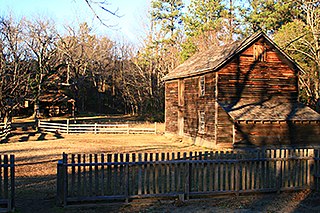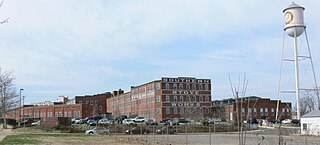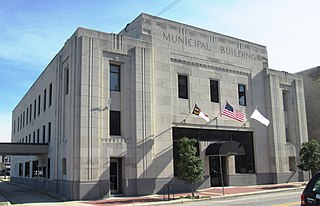
The American Tobacco Company was a tobacco company founded in 1890 by J. B. Duke through a merger between a number of U.S. tobacco manufacturers including Allen and Ginter, Goodwin & Company, and Kinney Brothers. The company was one of the original 12 members of the Dow Jones Industrial Average in 1896. The American Tobacco Company dominated the industry by acquiring the Lucky Strike Company and over 200 other rival firms. Federal Antitrust action begun in 1907 broke the company into several major companies in 1911.
Green Level is an unincorporated community in southwestern Wake County, North Carolina, United States. It was founded c. 1800 and is one of the best preserved crossroads communities in the county. Although historically connected to the town of Apex, Green Level now lies within the municipal jurisdiction of the town of Cary.

Duke Homestead State Historic Site is a state historic site and National Historic Landmark in Durham, North Carolina. The site belongs to the North Carolina Department of Natural and Cultural resources and commemorates the place where Washington Duke founded the nation's largest early-20th-century tobacco firm, the American Tobacco Company.

Durham station is an Amtrak station located in Durham, North Carolina. It is served by two passenger trains: the Carolinian and the Piedmont. The street address is 601 West Main Street and is located in West Village in downtown Durham. The station is open from 6:30am to 9:00pm daily. There is free, unattended parking at the station.

The Model Tobacco Factory is a historic industrial complex located in Richmond, Virginia. It was built beginning in 1938, and consists of ten contributing structures, including a prominent six-story rectangular factory building designed in the Art Deco style. The building was designed by the Chicago architecture firm of Schmidt, Garden and Erikson and is known for its Moderne "sky sign" that dominates the north end of the building.

W.T. Blackwell & Co. Tobacco was a tobacco manufacturer in Durham, North Carolina. It was best known as the original producer of Bull Durham Tobacco, the first nationally marketed brand of tobacco products in the United States. The Blackwell tobacco factory in Durham, built in 1874, was declared a National Historic Landmark in 1977. It is included in the American Tobacco Company Manufacturing Plant historic district, and is now occupied by apartments.

The North Prince Street Historic District is an historic, American tobacco warehouse complex and national historic district located in Lancaster, Lancaster County, Pennsylvania.

William Jackson Hicks (1827–1911) was a builder, architect and prison warden of North Carolina. He supervised a prison labor run brickworks and supplied bricks for use in the construction of a prison, other state buildings, and for use in private construction.
Linthicum & Linthicum was an architectural firm in North Carolina. It was a partnership of Hill Carter Linthicum (1860–1919) who was a prolific architect, and H. Colvin Linthicum, his son.

Southern Stove Works is a historic factory complex located in the Three Corners District of Richmond, Virginia. The complex includes four contributing red brick buildings built between 1902 and 1920. The buildings housed the foundry, assembly operations, warehouse storage, and metal storage. In 1920, Southern Stove Works vacated the buildings and moved to their new facility, Southern Stove Works, Manchester. By 1921, these buildings were occupied by the J. P. Taylor Leaf Tobacco Company.

The Carver Industrial Historic District is a national historic district located at Carver, Richmond, Virginia. The district encompasses 13 contributing buildings located west of downtown Richmond. The industrial area developed between 1890 and 1930, along the tracks of the Richmond, Fredericksburg and Potomac Railroad. The buildings are in a variety of popular 19th-century and early 20th century architectural styles including Queen Anne and Romanesque.

The American Tobacco Historic District is a historic tobacco factory complex and national historic district located in Durham, Durham County, North Carolina. The district encompasses 14 contributing buildings and three contributing structures built by the American Tobacco Company and its predecessors and successors from 1874 to the 1950s. Located in the district is the separately listed Italianate style W. T. Blackwell and Company building. Other notable contributing resources are the Romanesque Revival style Hill Warehouse (1900), Washington Warehouse (1902–07), the Lucky Strike Building (1901–02), and Reed Warehouse; Noell Building ; Power Plant and Engine House (1929–39); and the Art Moderne style Fowler (1939) Strickland (1946) and Crowe (1953) buildings.

Bullington Warehouse is a historic tobacco storage warehouse located at Durham, Durham County, North Carolina, United States. It was built in 1927, and is a three-story Romanesque-style brick structure divided into four units by projecting corbeled firewalls. Each unit has approximately 10,000 square feet per floor, giving a total of about 123,000 square feet. It is an example of "slow burn" masonry and wood factory construction. It was the last in a series of brick tobacco storage warehouses, unique in their architectural style, begun in 1897 and ending with this warehouse in 1927. The building has been converted to residential use.

Smith Warehouse is a historic tobacco storage warehouse located at Durham, Durham County, North Carolina. It was built in 1906, and is a two-story Romanesque-style brick structure divided into 12 70-foot-wide units by projecting corbeled firewalls. The building measures 850 feet long and 100 feet wide and features ornamental brickwork. It is an example of "slow burn" masonry and wood factory construction. It was the last of the 12 brick tobacco storage warehouses erected by The American Tobacco Company trust beginning in 1897. The building has been converted for academic and administrative uses.

Watts and Yuille Warehouses, also known as Brightleaf Square, are two historic tobacco storage warehouses located at Durham, Durham County, North Carolina. They are part of the Bright Leaf Historic District. They were built in 1904, and are two identical buildings parallel to each other with a courtyard in between. They are two-story Romanesque-style brick structures, seven bays wide and twenty bays long. Each unit of the warehouses is 75 feet by 118 feet, for a total of 35,400 square feet on each floor. They are an example of "slow burn" masonry and wood factory construction. They were among the 12 brick tobacco storage warehouses erected by The American Tobacco Company trust beginning in 1897. The buildings have been converted to retail and office use.

Trinity Historic District, also called Trinity Park, is a national historic district and residential area located near the East Campus of Duke University in Durham, North Carolina. The district encompasses 751 contributing buildings in a predominantly residential section of Durham. They were built between the 1890s and 1960 and include notable examples of Queen Anne and Bungalow / American Craftsman style architecture. Located in the district are the separately listed "Faculty Row" cottages: the Bassett House, Cranford-Wannamaker House, Crowell House, and Pegram House. Other notable buildings include the George W. Watts School (1917), Julian S. Carr Junior High School (1922), Durham High School (1923), Durham Alliance Church (1927), Trinity Avenue Presbyterian Church (1925), Watts Street Baptist Church (1925), Great A & P Tea Company (1927-1929), Grace Lutheran Church, and the former Greek Orthodox Community Church.

Greenville Tobacco Warehouse Historic District is a national historic district located at Greenville, Pitt County, North Carolina. The district encompasses seven contributing buildings and one contributing structures in an industrial section of Greenville. It includes buildings dated from about 1905 to 1947 and notable examples of Art Deco and Italianate style industrial architecture. Contributing resources are the American Tobacco Company Storage Warehouse #2. ; the Prichard-Hughes Warehouse ; the Dail-Ficklen Warehouse ; the Export Leaf Factory ; the E. B. Ficklen Factory ; the Gorman Warehouse (1927); the Star Warehouse (1930); and the System of CSX Railroad Tracks.

Reidsville Historic District is a national historic district located at Reidsville, Rockingham County, North Carolina. It encompasses 324 contributing buildings, 1 contributing site, 11 contributing structures, and 1 contributing object in the central business district and surrounding residential sections of Reidsville. It was developed between about 1865 and 1941, and includes notable examples of Italianate, Queen Anne, American Craftsman, and Classical Revival style architecture. Located in the district are the separately listed Penn House and Gov. David S. Reid House. Other notable buildings include the Oaks-Motley House, Colonel A. J. Boyd House (mid-1870s), Reid Block (1880s), Citizens' Bank Building, William Lindsey and company Tobacco Factory, First Baptist Church, Main Street Methodist Church, Melrose (1909) designed by architect Richard Gambier, R. L. Watt house designed by Willard C. Northup, First Presbyterian Church (1922), St. Thomas Episcopal Church, Grand Theatre, Belvedere Hotel, United States Post Office and Federal Building, and the Municipal Building (1926).

The Wilson Central Business–Tobacco Warehouse District is a national historic district located at Wilson, Wilson County, North Carolina. It encompasses 152 contributing buildings, 20 contributing sites, and 2 contributing structures in the central business district of Wilson. The district includes notable examples of Late Victorian and Art Deco style architecture. Located in the district are the separately listed Branch Banking Building, Cherry Hotel, and Wilson County Courthouse. Other notable buildings include the Woodard-Watson Warehouse, Planter's Warehouse, Passenger Station and Freight Depot (1924), Jackson Chapel First Baptist Church (1913), St. John's African Methodist Episcopal Church (1915), Imperial Tobacco Company, Winstead-Hardy Building, Rountree Building (1870s), Planter's Bank Building (1920), United States Post Office and Courthouse (1927), Charles L. Coon High School (1922), First National Bank of Wilson Building (1927), Wilson Theatre (1922), Odd Fellows Lodge (1896), and the Works Projects Administration financed Wilson Municipal Building (1938).

The American Tobacco Company Warehouses Complex is a pair of brick warehouses built around 1900 in Madison, Wisconsin. They are now the two most intact remnants of Madison's tobacco industry, and were added to the National Register of Historic Places in 2003.






















